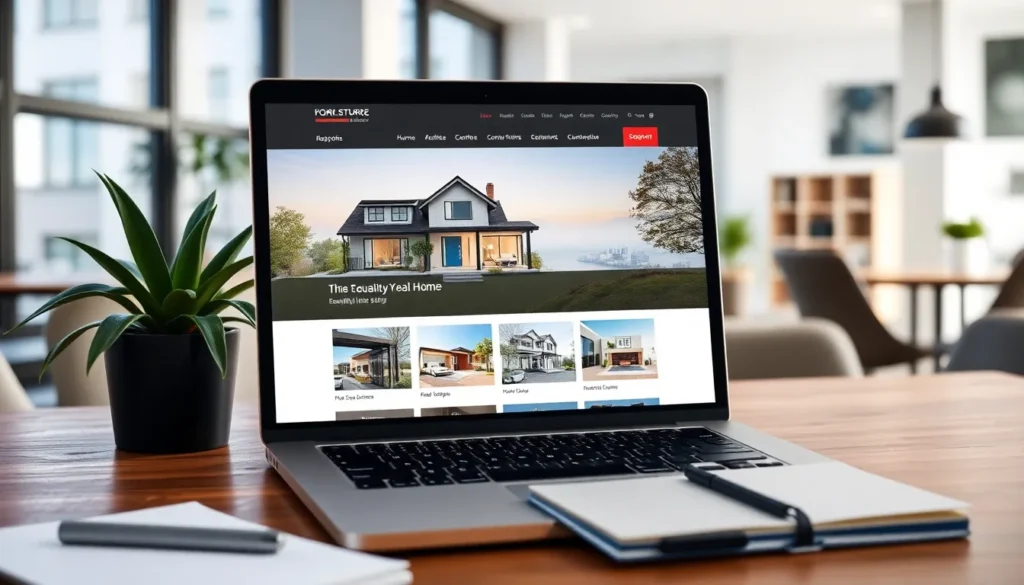In the fast-paced world of real estate, a stunning website isn’t just a luxury—it’s a necessity. Picture this: a potential buyer scrolling through listings, and suddenly they land on a site that’s so beautifully designed, it feels like a cozy home. That’s the magic of effective real estate web design. It’s not just about looking pretty; it’s about creating an experience that keeps clients engaged and coming back for more.
Importance Of Real Estate Web Site Design
Effective web design plays a crucial role in the real estate industry. A visually appealing website attracts potential buyers and generates leads. User-friendly layouts simplify navigation, allowing clients to find properties quickly. Responsive designs enable optimal viewing on different devices, enhancing user experience.
Statistics show that 75% of users judge a company’s credibility based on its website design. Impressive aesthetics create a first impression that encourages clients to explore further. Functionality is equally important; features such as search filters and property comparisons empower users. High-quality images and virtual tours make listings more appealing and can increase engagement.
Search engine optimization (SEO) must be integrated into web design strategies. Properly optimized sites rank higher in search results, enhancing visibility. Local SEO techniques attract clients searching for properties in specific areas. Incorporating relevant keywords into property descriptions boosts organic traffic.
Branding should also reflect through the design. Consistent colors, fonts, and logos reinforce brand identity. Unique selling propositions can be highlighted prominently, differentiating agents from competitors.
Maintenance of the website is essential for ongoing success. Regular updates ensure that content stays current and relevant. Performance monitoring, including analysis of user behavior, informs design adjustments that enhance functionality.
Prioritizing design elements that resonate with target audiences ultimately leads to increased client satisfaction. A well-designed real estate website not only enhances aesthetics but also drives engagement and conversions, solidifying its importance in the industry.
Key Elements Of Effective Design

Effective web design in real estate hinges on several critical elements that enhance user experience and engagement. Prioritizing these components ensures the site not only attracts visitors but also converts them into clients.
User-Friendly Navigation
User-friendly navigation empowers clients to locate properties effortlessly. Clear menu structures and intuitive layouts promote seamless exploration of listings. Categorizing properties into logical sections simplifies the search process, allowing users to filter by price, location, or amenities. Consistent call-to-action buttons lead clients towards crucial steps, such as scheduling viewings or signing up for newsletters. A site’s usability impacts retention rates; a staggering 38% of users will stop engaging with a website if they find it unattractive or difficult to navigate.
Visual Appeal
Visual appeal significantly influences first impressions. High-quality images and engaging video tours showcase properties effectively, enticing potential buyers to explore further. Utilizing a cohesive color scheme and professional graphics enhances brand identity and creates a polished look. Typography matters too; readable fonts and ample white space contribute to an enjoyable browsing experience. According to research, visually driven sites lead to a 94% increase in user credibility, underscoring the necessity for aesthetic design in real estate web presence.
Mobile Responsiveness
Mobile responsiveness reflects the growing trend of users seeking listings on various devices. An optimized site ensures that images, text, and navigation adapt smoothly to different screen sizes. Prioritizing mobile usability increases accessibility, making it easier for clients to browse while on the go. Statistics reveal that over 50% of online property searches occur on mobile devices, emphasizing the necessity for responsive design. Implementing a mobile-first approach not only enhances client satisfaction but also improves search engine rankings, ensuring greater visibility in a competitive digital landscape.
Best Practices In Real Estate Web Site Design
Effective real estate web design enhances user experience and engagement. Prioritizing specific elements significantly influences client satisfaction and overall website performance.
High-Quality Imagery
High-quality imagery captivates potential buyers. Listings with professional photographs attract 94% more views compared to those lacking visuals. Using clear, vibrant images creates a polished look and conveys property details effectively. Additionally, incorporating virtual tours provides an immersive experience, allowing clients to visualize living in the space. Properties showcased with stunning images can significantly increase inquiries, leading to higher conversion rates.
Clear Calls-To-Action
Clear calls-to-action guide users toward desired outcomes. Placing buttons like “Schedule a Tour” or “Contact an Agent” prominently encourages immediate engagement. Each call-to-action should be concise and actionable to eliminate confusion. Strategically positioning these buttons throughout the site enhances navigation and improves user experience. Effective calls-to-action can result in a 202% increase in conversions. Ensuring users know their next step streamlines the purchasing process.
SEO Optimization
SEO optimization is crucial for boosting website visibility. By incorporating targeted keywords within property descriptions, agents enhance searchability in local markets. Meta tags, image alt texts, and engaging content further improve rankings on search engines. Approximately 70% of online traffic originates from organic search results, making it vital to employ effective strategies. Regularly updating content with relevant keywords also maintains visibility and attracts consistent traffic. Prioritizing local SEO techniques can effectively draw in potential buyers in specific geographical areas.
Common Mistakes To Avoid
Designing a real estate website involves critical choices that can impact user experience. Avoiding common pitfalls enhances effectiveness and engagement.
Overcomplicated Layouts
Complicated layouts often confuse visitors, leading to frustration. Users tend to disengage when they can’t find information quickly. Simple, intuitive designs facilitate navigation and encourage exploration. Clear menu structures help clients locate property listings without hassle. It’s vital to prioritize usability over extravagance. A streamlined layout contributes to a positive first impression, boosting user retention.
Neglecting Mobile Users
Mobile optimization must be a priority, as over 50% of property searches occur on mobile devices. Designers should ensure adaptability across various screen sizes. A lack of mobile responsiveness directly affects user experience, often resulting in high bounce rates. Failure to cater to mobile users can alienate potential clients seeking properties on-the-go. Providing a seamless mobile experience improves engagement and increases conversion rates. Prioritizing this aspect directly impacts visibility in search engine rankings.
Conclusion
A well-designed real estate website is crucial for success in today’s competitive market. It not only attracts potential buyers but also fosters a positive user experience that keeps clients coming back. Prioritizing user-friendly navigation and mobile responsiveness ensures that visitors can easily find what they’re looking for.
Incorporating high-quality images and engaging virtual tours significantly enhances listings and boosts inquiries. By integrating effective SEO strategies, agents can improve their online visibility and reach a broader audience. Regular maintenance and updates will keep the site relevant and appealing, ultimately driving engagement and conversions.
Investing in thoughtful web design is a strategic move that can set real estate professionals apart from the competition and lead to lasting success.

